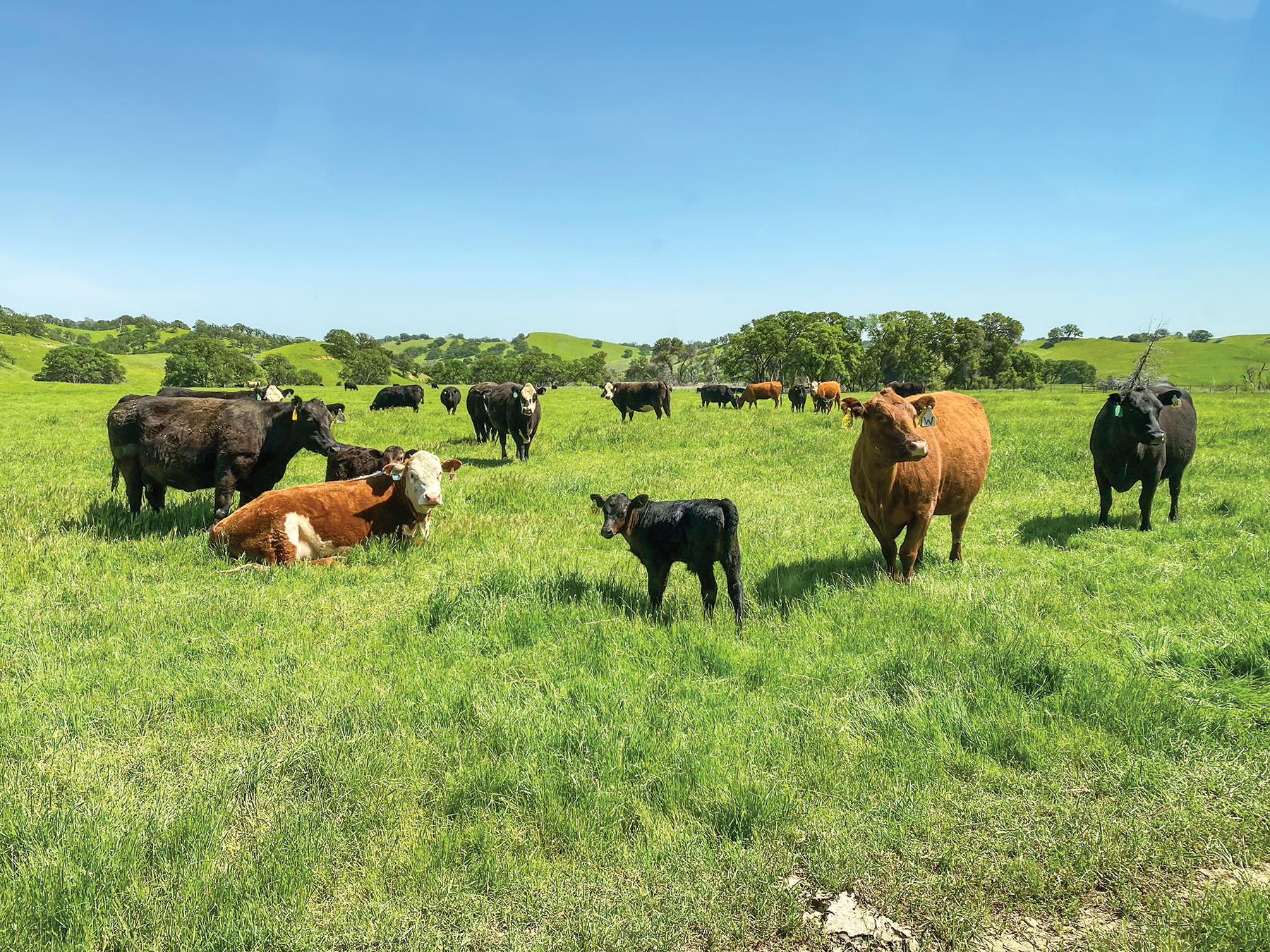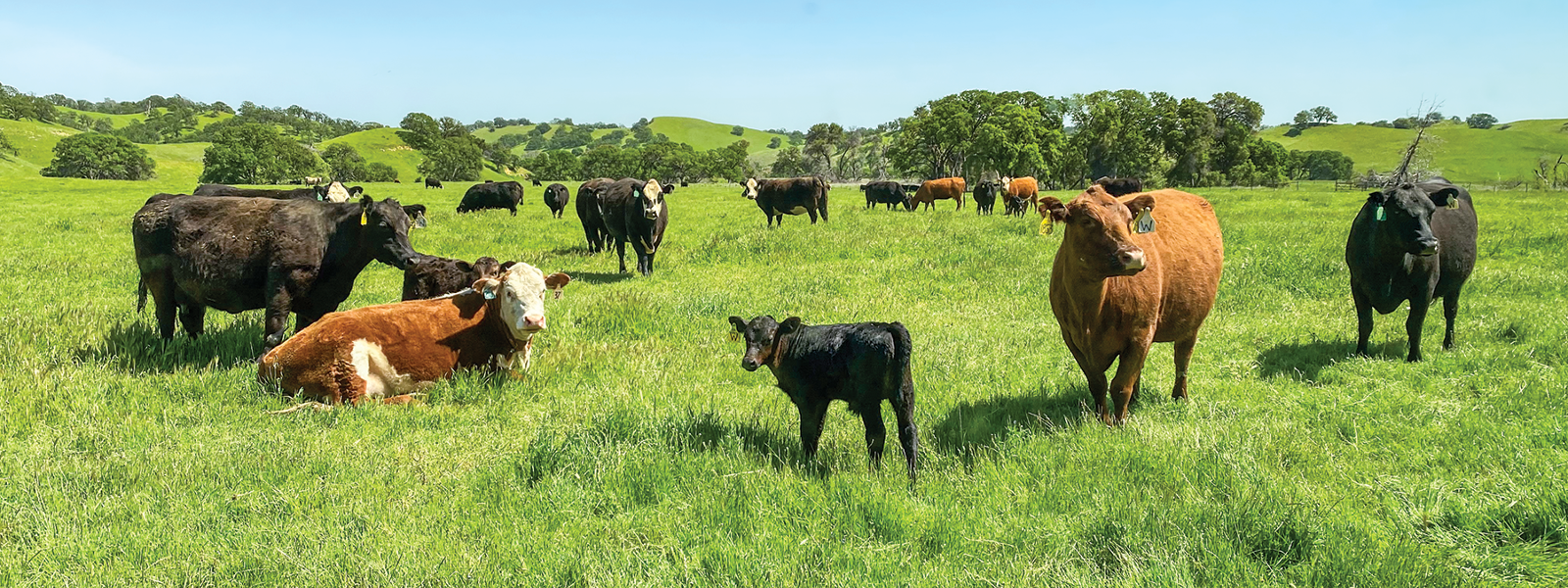Two ranches provide look at cattle raising, management

Cattle graze on Yolo Land and Cattle Co.’s 7,500-acre ranch in Woodland. Owned by the Stone family, the property is seeing improved feed conditions this year after 40 inches of winter and spring rains. Before that, years of drought and impacts from two wildfires forced the family to reduce its herd.
Photo/Ching Lee

By Ching Lee
Impacts from the multiyear drought and wildfires have not made cattle raising easy for California ranchers, some of whom have turned to direct marketing, diversification and other ventures to help keep their businesses sustainable and growing.
Two ranching operations in Yolo County have found ways to carve their own niche, allowing each to help maintain the region’s rich agricultural tradition.
The ranches opened their doors this month to a group of state legislative and committee staffers, offering a glimpse of how they manage their land, livestock and natural resources. The educational tour was hosted by the California Farm Bureau, California Bountiful Foundation and California Cattle Council.
“These tours are so important to highlight the importance of beef cattle ranching, which produces a safe, nutritious protein source for local, national and international food security,” said Amrith Gunasekara, director of science and research for the California Bountiful Foundation. “There is a lot of misinformation out there about dairy and meat production, including animal well-being and health, and we hope these tours will help to change the narrative.”
The Yocha Dehe Wintun Nation raises cattle as part of a diverse farming operation that includes more than a dozen crops, with production of wine, olive oil and honey marketed under the Seka Hills brand. The tribe runs 800 head of cattle on 20,000 acres of rangeland, according to its website.
The ranch’s headquarters in the Capay Valley also serves as the feedlot, where cattle as old as 14 to 20 months are finished for 90 to 120 days, said ranch manager Bill McDonald. The spring- and fall-calving herd spends winter on irrigated pastures in Yolo County until April or May. Then it goes to greener pastures in Modoc County, where it stays until November.
Finished beef products are sold at the tribe’s Seka Hills tasting room and via its beef club. Business has grown, McDonald said. When he first started managing the herd, the ranch was processing 24 head a year, or six every quarter, he noted. Today, it sells eight to 10 head every quarter.
“It seemed like during COVID, it really blew up. There was a lot of interest for locally sourced beef and natural beef,” he said, noting the cattle are fed a diet with no genetically engineered feeds and receive no antibiotics or added hormones.
He credited the growth to “a little better feeding regime,” which has resulted in better-quality beef. Beef club prices also stayed “pretty competitive,” he said, even as the price of beef in stores was “going through the roof” during the pandemic. Plus, he said he thinks beef club members, most of whom are from the greater Sacramento region, like the idea of buying locally.
“They want to know where their food is coming from, especially when they come out to pick it up,” McDonald said. “They see the range and see where the cattle are. There’s cattle on the hills grazing. They like the visual and connection.”
Cattle not marketed to the beef club are sold unfinished at auction, typically via the Western Video Market. McDonald noted that a set of calves weighing 850 pounds recently sold for $2.30 to $2.50 a pound, or $1,600 to $2,000 a head.
Another market outlet for the ranch is Texas-based 44 Farms, which is linked to Walmart’s private-label beef line. The farm has been “buying a bunch of our calves the last couple years because they want an all-black, natural herd,” McDonald said.
At Yolo Land and Cattle Co. in Woodland, rancher Casey Stone and his family have reduced their spring-calving herd to 300 to 400 head of cattle. They used to run about 700 mother cows, but five years of drought and two wildfires on the ranch “took their toll on us,” Stone said.
“We’ve cut our cow numbers down to the point where it’s not quite a sustainable level,” he added.
With 40 inches of rain this year, Stone said he’s seeing a heavier calf crop because of improved feed conditions on the 7,500-acre ranch. But he noted grasses only started growing during the past few weeks with the warmer temperatures. He described the past winter as “good” but “hard,” as the deluge washed out roads and left downed trees everywhere, necessitating “a tremendous amount of cleanup.”
A national beef shortage means he’ll earn “a lot higher price” for his cattle this year, he said, adding “we just wish we had more of them” to sell. With better pastures, the ranch could now support a larger herd, but he said he can’t expand his numbers unless he buys more cows, “and this is the worst time to buy cows because they’re expensive” due to the supply shortage.
“We’re trying to diversify ranch income as much as we can,” Stone said.
The family rents part of the ranch to a Half Moon Bay drone company that uses the grounds for testing. Stone described the company as “excellent tenants,” and its plane are “very quiet” and “don’t bother the cattle.”
About 23 years ago, the family started selling its own brand of beef jerky, though Stone noted he doesn’t use his own beef for the jerky due to “the logistics of trying to kill your own cattle just for that.” Plus, he would have to sell the product for twice what he’s charging now.
“Basically, I’m a custom label guy selling product out there,” he said. Though he’ll keep the jerky business going for now, he noted the “many brands out there” he’s competing against.
In addition to selling jerky from the company’s website, the Stone family has diversified into selling beef directly to customers, also through the website.
The company raises mainly grass-fed and -finished Angus cattle as its commercial herd, with some Angus-Hereford crosses. It branched out to also raising Wagyu cattle three years ago. Those animals are sold to a Wagyu supplier in Washington.
Stone said Wagyu meat has “excellent marbling tendencies,” but the calves—weighing a tiny 50 pounds at birth—are “not very hardy.” As such, he’s had “a lot of problems” with them, losing “a lot of calves” last year to pneumonia and depredation.
To preserve the ranch, the family has placed it under a conservation easement since 2005 with the California Rangeland Trust. Stone said the move allowed his family to further diversify its business by buying self-storage facilities.
“That’s actually what pays the bills right now. The cows don’t,” he said. “It just balances things out, so at least you have something to keep you going. If we were trying to rely on just the cattle deal, it would be pretty rough.”
With so much agricultural land being lost, Stone said conservation easements allow his family to keep the ranch property intact even if future generations decide not to farm it. Worst-case scenario, the property could be rented to another producer, he added.
Standing in fields of green with cattle grazing in the background and rolling hills around him, Stone said, “You hate to see something like this carved up.”
(Ching Lee is an assistant editor of Ag Alert. She may be contacted at clee@cfbf.com.)




